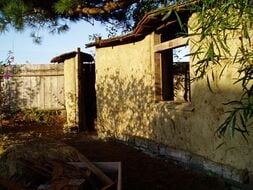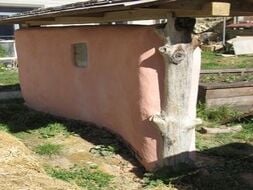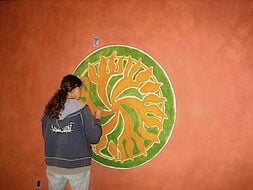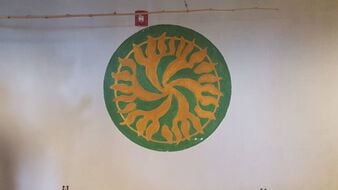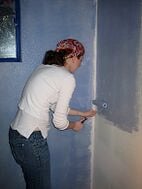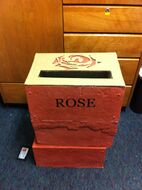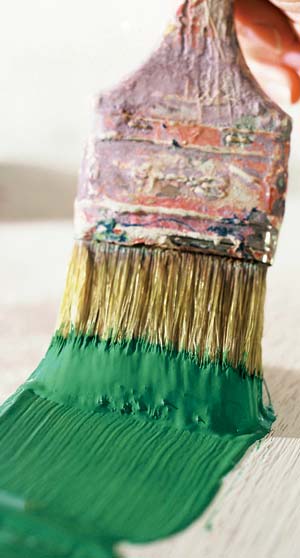
Natural paint is often a safer and more local alternative to conventional paints that can be high in VOCs and emboddied energy.
This page describes natural paints as a potential component of United States of America home construction. Only a few decades ago, the petrochemical industry largely took over the production of oil-based and water-based paints. The idea that paint should be able to breath was abandoned. Also, added synthetic chemicals are very harmful to humans and animals. Natural paints derived from plant and mineral materials have subtle, soothing colors, pleasant scents, and help create a healthy environment.[2] Natural paints avoid indoor air pollution and can have an unusual, attractive appearance.
A Brief History[edit | edit source]
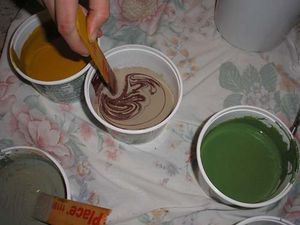
Creating durable, beautiful paints out of natural ingredients is not a new phenomenon. For millenia, people have been using the materials around them to create paints to color their worlds. Examples of natural paints can be found in the earliest cave drawings. They can be found in the world's most prestigious museums. And they can be found in the average home.
Over time, synthetic, toxic and energy-intensive materials -- such as formaldehyde -- were added to the paints that people use in their homes.[3] These materials weren't added specifically to cause harm, but that didn't lessen their harmful effects. Some of these materials include synthetic dyes to increase color choices, additives to combat mold, and non-water-based binders such as petroleum products and heavy metals which were designed to withstand high use areas like kitchens.[4] A notable example is the lead-based paints that were once popular, but have now been linked to serious health risks.
But interest in natural paints has recently resurfaced in the face of growing concern for our environment, bringing people back to the techniques and materials that have stood the test of time. Still, it is important to understand that "natural" doesn't automatically mean "non-toxic" or "safe." Please use the information on this page to help inform your decisions about which natural paints are best for you and your home.
Below are examples of natural paints in action: beautiful, durable, and eco-groovy.
-
A fresco from a house in the ancient Roman city of Herculaneum. Likely painted with chalk, charcoal and colored earth on damp lime plaster, this style of fresco did not require a binder in the paint to adhere to the wall.[5]
-
Madonna and Child by Duccio, 1284 A.D. This painting is tempera, an egg-based paint, and gold on wood. Tempera paintings are very long lasting, and examples from the first centuries AD still exist.[6]
-
Colin Campbell Cooper's Flatiron Building, 1908, is casein (milk-based paint) on canvas.[7]
-
This piece is created in the Nirmal style of painting. Named after a town in India, even modern Nirmal paintings remain true to the traditional techniques, including using natural ingredients like tamarind seed, herbs and mud.[10]
-
Flour paint can be applied to most interior surfaces, including this fireplace.[11]
-
Students at Cal Poly Humboldt use egg paint to create this logo for the interior wall of the Campus Center for Appropriate Technology.[12]
Natural Paint Basics[edit | edit source]
Paint generally has three main ingredients or parts.
- The first part is the pigment, which is responsible for the color of the paint.[13]
- The second part is the solvent. The solvent keeps the paint in liquid form and evaporates off as the paint dries.[4]Solvent can also be used during the painting process to clean paint spills and correct mistakes.[13]
- The third part of paint is the binder, which, as its name suggests, binds the paint together. This is the main body of paint.[13]
A lot of Paints have additional components in it, that are generally not neccessary but can improve the Paint. For example: fillers can be used to manipulate the texture and consistency of paint, and to reinforce the binder.[13] On the other hand paints like lime have only two components: water and binder (the binder is also the pigment and not separate).
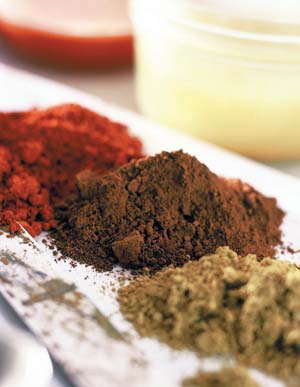
Drawbacks of synthetic paints[edit | edit source]
VOCs/Indoor Air Quality[edit | edit source]
- Volatile Organic Compounds, or VOCs, such as those found in synthetic household paints can cause physical irritation and/or damage including irritation of eyes, nose and throat, headaches, loss of coordination, nausea, liver, kidney and central nervous system damage and some are carcinogenic.[15]
- Common organic pollutants (including VOCs) have been found in higher concentrations within the home than outside.[15]
- Paints labeled "no-VOC" and "zero-VOC" can still legally contain up to 5g/L of VOCs.[4]
- Modern "lead-free" synthetic paints can still have as much as 0.06% lead which scientists fear could be harmful to small children, even at low levels.[16]
Waste[edit | edit source]
- By volume, household paints account for a large portion of household hazardous waste in US homes.[17]
- Household latex paint, oil-based paint and paint thinner are considered "hazardous waste" by the EPA.[18]
- Although considered less detrimental to health and the environment than oil-based paints, latex paint contains hazardous ingredients such as acrylics, vinyls and epoxies.[19]
- In California specifically, latex paint must be disposed of in a Class I hazardous waste landfill.[20]
- Oil-based paints commonly contain petrochemical products as a solvent.[20]
- Until 1990, mercury was used as an ingredient in oil-based and latex household paints. Leftover oil-based and latex household paints from before then may contain mercury, and oil-based paints that are several years old may also contain lead.[17]
- In the UK, the government also classifies household paint as "hazardous waste."[21]
- Because synthetic household paints contain hazardous ingredients, they cannot be thrown into a regular garbage can. Depending on the type of paint, the disposal process may include tedious drying-out processes, finding a recycling center that accepts paint or locating hazardous waste collection programs.[22]
- People with unused or leftover household paints that can be classified as hazardous waste are encouraged to donate, return or swap paint to reduce waste.[17]
- Even in production, it is estimated that for every 1000 kilograms of synthetic paint produced, 10,000 kilograms of waste are created. For specialty paints, this can be as high as 30,000 kilograms of waste.[21]
- Titanium dioxide is a key ingredient in synthetic paints, and must be mined and processed in environmentally damaging ways.[21]
Impacts of natural paint[edit | edit source]
Advantages[edit | edit source]
- Using natural paint can reduce the amount of VOCs present in the home, improving indoor air quality.
- Natural paints are microporous, allowing the walls to breathe. Because moisture is not trapped between the wall and the layer of paint, there is no blistering or peeling.[23]
- Natural paints do not use petroleum products and contain ingredients from sustainable sources.[23]
- Because of their non-toxic, natural ingredients, many natural paints are biodegradable, easily disposed of and even fit for a household compost pile once dried. This reduces landfill mass, environmental pollution and disposal costs compared to synthetic paints.[24]
Disadvantages[edit | edit source]
- Natural paints, especially store bought, may be more expensive than synthetic paints.[25]
- Natural paints may be more difficult to work with than synthetic paints because of texture, rate of drying and inconsistent coloring from batch to batch.[12]
- Although anecdotally durable and resistant, there is a lack of performance data on natural paints, so it is important to test natural paint before committing to a contract.[25]
| Manufacturer | Type of Paint | VOC Content (lb/gal) | Approximate Cost ($/gal) |
|---|---|---|---|
| Krylon[26] | Industrial, water-based epoxy paint | 1.36 | 44 |
| Benjamin Moore[27] | Super Spec HP interior latex paint | 0.48 | 34 |
| The Natural Paint Company[28] | Casein marble interior paint | 0.00 | 82 |
Types[edit | edit source]
Water-based[edit | edit source]
Water-based paints are the best choices for an environmentally-friendly solvent[verification needed]. Distemper and lime wash are two popular examples.[13]
Casein or Milk[edit | edit source]
Casein paint is made from a protein commonly found in dairy, and is often called "milk paint" or "milk-based paint." This paint is mold resistant, durable and compostable.[13]However, if not allowed to dry properly, milk-based paint can sour or mold.[29]
Tempera or Egg[edit | edit source]
Egg-based paint is durable and quick to dry. It dries to a glossy finish.[13]
Flour[edit | edit source]
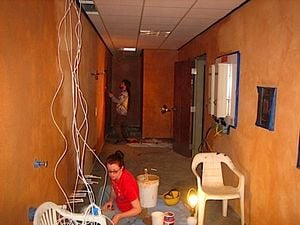
Flour paint is one of the most versatile paint types and can be used inside or outside, on wood, stone, drywall, wallpaper, earthen and gypsum plaster, masonry and to cover existing painted surfaces. This paint is very thick and can destroy brushes, but the recipe can be tweaked a little to achieve different textures. Flour paint typically consists of water, flour, colored clay and more uncolored clay filler.[30]
See CCAT natural paint project#Flour Paint for a project that used this Natural paint.
Oil-based[edit | edit source]
Commonly made from linseed oil, natural oil-based paints are durable and have a velvety texture.[13]
Recipes[edit | edit source]
Here are some recipes on Appropedia:
- Distemper cellulouse paint
- Oil paint for wood
- Casein borax paint
- Quark and oil glaze
- Curdled milk paint recipe
- Flour paint recipe
- Egg and clove oil tempera paint
Examples[edit | edit source]
| Manufacturer | Product | Qualities | Advantages |
|---|---|---|---|
| Ecotrend Paint[31] | Egg-based interior paint | Anti-mold Anti-bacterial 120 colors |
No VOCs No harmful chemicals Odorless |
| Natural primers Vegan primer Interior paints of chalk, lime, plant-based casein, marble powder and clay |
Unlimited palette choice Stain-covering capability |
No VOCs Organic Hypo-allergenic |
Related projects[edit | edit source]
See also[edit | edit source]
- Bottoms strawbale earthen plaster
- CCAT natural paint project
- Curdled milk paint recipe
- Flour paint recipe
- Natural paint basics
- Parras natural paint gallery
- Clay plaster
- Lime: though not a "paint", can be used to color indoor rooms white
References[edit | edit source]
- ↑ Photo courtesy of Heather Brown.
- ↑ Building with Earth, Chelsea Green Publishing Company, 2001
- ↑ This information according to http://ezproxy.humboldt.edu/login?url=http://search.ebscohost.com/login.aspx?direct=true&db=afh&AN=4096867&site=ehost-live
- ↑ 4.0 4.1 4.2 This information according to http://greenhomeguide.com/know-how/article/selecting-green-paint
- ↑ This information according to http://web.archive.org/web/20110206120228/http://naturalpigments.com/education/article.asp?ArticleID=19
- ↑ 6.0 6.1 This information according to http://en.wikipedia.org/wiki/Egg_tempera
- ↑ This information according to http://commons.wikimedia.org/wiki/File:Colin_Campbell_Cooper_-_Flatiron_Building.JPG
- ↑ This image from http://farm1.static.flickr.com/40/100761143_226e540b49.jpg
- ↑ This information according to http://www.ibiblio.org/wm/paint/auth/munch/
- ↑ This information according to http://commons.wikimedia.org/wiki/File:File.Nirmal_Painting.jpeg
- ↑ Photo courtesy of Bill Steen.
- ↑ 12.0 12.1 This information according to CCAT natural paint project.
- ↑ 13.0 13.1 13.2 13.3 13.4 13.5 13.6 13.7 This information is according to Natural paint basics
- ↑ Photo courtesy of Heather Brown.
- ↑ 15.0 15.1 This information is according to http://www.epa.gov/iaq/voc.html
- ↑ This information is according to Painting the Town Green Aberdeen Proving Ground's Paint Pilot Project
- ↑ 17.0 17.1 17.2 This information according to Storing and Disposing of Paint from Your Home by OCAPP
- ↑ This information according to http://www.fairfaxcounty.gov/dpwes/trash/disphhw.htm
- ↑ This information according to http://web.archive.org/web/20201017205522/https://www.des.nh.gov/organization/commissioner/p2au/pps/hhwp/paint/latex.htm
- ↑ 20.0 20.1 This information according to http://www.calrecycle.ca.gov/condemo/paint/
- ↑ 21.0 21.1 21.2 This information according to http://www.theecologist.org/green_green_living/home/268680/natural_house_paintsgood_enough_to_eat.html
- ↑ This information according to http://web.archive.org/web/20201017205522/https://www.des.nh.gov/organization/commissioner/p2au/pps/hhwp/paint/latex.htm
- ↑ 23.0 23.1 This information according to http://web.archive.org/web/20131127062230/http://www.mikewye.co.uk:80/TheBenefitsofNaturalPaints.pdf
- ↑ This information according to http://web.archive.org/web/20121115133357/http://www.bot.yildiz.edu.tr:80/ids09/_data/_readings/DESIGN%20AND%20DETAILING%20FOR%20DECONST.pdf
- ↑ 25.0 25.1 This information according to http://web.archive.org/web/20120728061951/http://www.seattle.gov/purchasing/pdf/RPNPaint.pdf
- ↑ This information according to http://www.utilitysafeguard.com/Krylon-Paint/Industrial-Coatings/Rust-Tough-Acrylic-Enamel_11/
- ↑ This information according to Benjamin Moore® Super Spec HP® Latex Flat Fire Retardant P59
- ↑ 28.0 28.1 This information according to https://naturalpaint.com.au/
- ↑ This information according to Paula Baker-Laporte, Erica Elliot and John Banta, "Prescriptions for A Healthy House. A Practical guide for Architects, Builders & Homeowners." New Society Publishers, 2001.
- ↑ Steen, B., (2006). "Make Safe, Natural Paint." Mother Earth News (218), http://www.motherearthnews.com/DIY/2006-10-01/Make_Safe_Natural_Paint.aspx [accessed 2/3/2007].
- ↑ This information according to http://www.naturalinteriorpaint.com/about.html
![A fresco from a house in the ancient Roman city of Herculaneum. Likely painted with chalk, charcoal and colored earth on damp lime plaster, this style of fresco did not require a binder in the paint to adhere to the wall.[5]](/w/images/thumb/e/e4/Herculaneum_Fresco.jpg/120px-Herculaneum_Fresco.jpg)
![Madonna and Child by Duccio, 1284 A.D. This painting is tempera, an egg-based paint, and gold on wood. Tempera paintings are very long lasting, and examples from the first centuries AD still exist.[6]](/w/images/thumb/6/6b/Duccio_The-Madonna-and-Child.jpg/81px-Duccio_The-Madonna-and-Child.jpg)
![Colin Campbell Cooper's Flatiron Building, 1908, is casein (milk-based paint) on canvas.[7]](/w/images/thumb/c/c6/The_Last_Supper.jpg/120px-The_Last_Supper.jpg)
![The Scream, or The Cry by Edvard Munch is casein, tempera and wax crayon on cardboard.[8][9]](/w/images/thumb/e/eb/Edvard-Munch_The-Scream.jpg/93px-Edvard-Munch_The-Scream.jpg)
![This piece is created in the Nirmal style of painting. Named after a town in India, even modern Nirmal paintings remain true to the traditional techniques, including using natural ingredients like tamarind seed, herbs and mud.[10]](/w/images/thumb/0/0c/Nirmal_Painting.jpg/120px-Nirmal_Painting.jpg)
![Flour paint can be applied to most interior surfaces, including this fireplace.[11]](/w/images/thumb/a/a0/Fireplace_byBillSteen.jpg/89px-Fireplace_byBillSteen.jpg)
![Students at Cal Poly Humboldt use egg paint to create this logo for the interior wall of the Campus Center for Appropriate Technology.[12]](/w/images/thumb/d/d3/NP78.jpg/120px-NP78.jpg)
